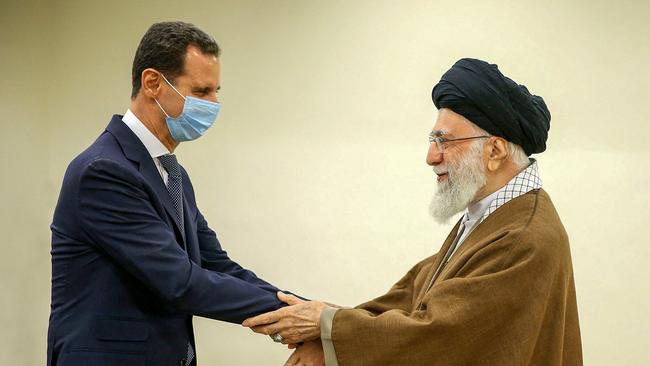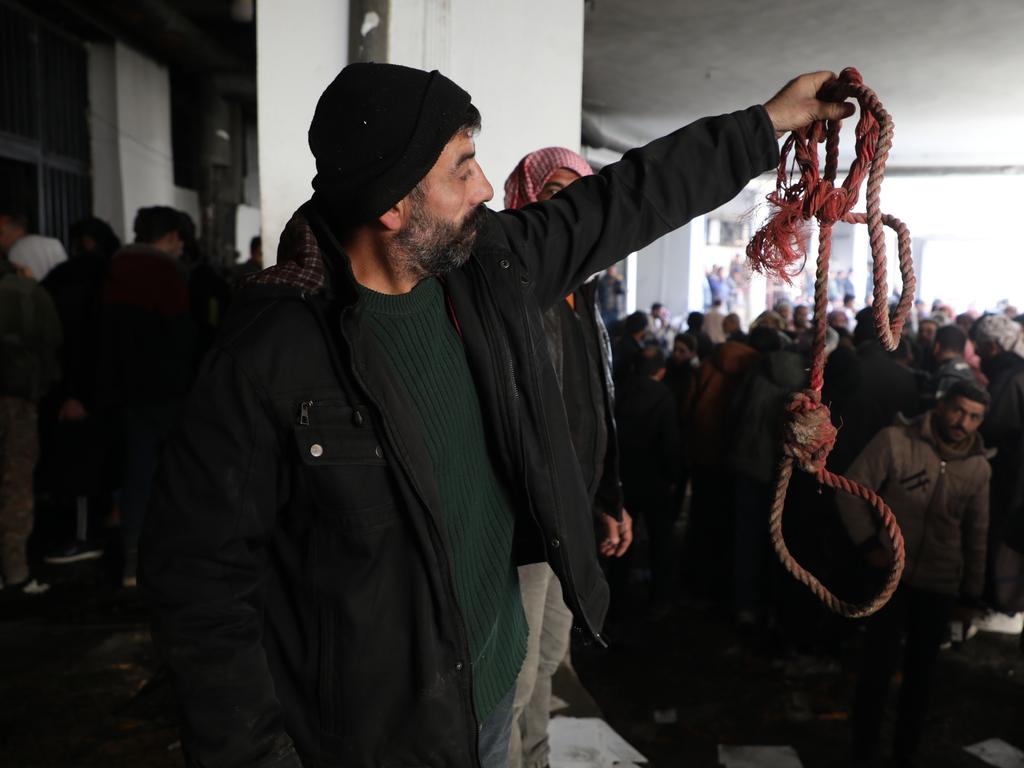Iran suffers blow of ‘historic proportions’ with Bashar al-Assad’s fall
The departure of Bashar al-Assad is the latest strategic catastrophe that will force Iran to rethink decades-old security policies, just as it is also confronting Donald Trump’s election and his promises of new pressure on Tehran.

Iran spent decades and billions of dollars building a network of militias and governments that allowed it to exercise political and military influence across the Middle East, and deter foreign attacks on its soil.
In a matter of weeks, the pillars of that alliance came crashing down. The departure of Syria’s Bashar al-Assad is the latest strategic catastrophe that will force Iran to rethink decades-old security policies, just as it is also confronting the election of President-elect Donald Trump and his promises of new pressure on Tehran.
Assad’s removal is also the climax so far in a cascade of events catalysed by the Hamas attack on Israel on Oct. 7 last year, which resulted in the most fundamental change in Iran’s security landscape since the American invasion of Iraq in 2003. But, while the toppling of Saddam Hussein ultimately provided Iran with opportunity, this time Tehran is at a disadvantage.
In more than a year of attacks, Israel has devastated Hamas, Iran’s main Palestinian ally. Since September, Israel has killed most of the leadership of Hezbollah, the Lebanese militia that is Iran’s most powerful ally, and sent its surviving top commanders into hiding. Assad’s toppling destroys the remaining front line of Iran’s so-called “forward defence,” said Ali Vaez, director of the International Crisis Group’s Iran Project.
“The Islamic Republic thought that Hamas’s 7 October attack was a turning point in history. That’s true, but in the entirely opposite direction to what it hoped for,” he said. “The dominoes for its western front have fallen one after the other.”

Syria was Iran’s only state ally in the Middle East. More important, it provided Iran with land access to Hezbollah, the centrepiece of its self-labelled “axis of resistance,” which thanks to Tehran’s support became the world’s best-armed nonstate actor.
“There is no axis of resistance without access to Hezbollah,” Vaez said. Iran is grappling with this new security landscape at a time when its clerical leadership is ageing, with Supreme Leader Ayatollah Ali Khamenei turning 86 years old next year. The Islamic government’s popularity at home is waning, and its arch-enemy Israel is emboldened.
The past year’s setbacks have raised concerns that Iran might accelerate its nuclear program to restore some deterrence against foreign attacks. For months, Iranian officials have openly debated whether to increase its nuclear efforts, and whether to reconsider Khamenei’s two-decade-old pledge not to procure weapons of mass destruction.
A US intelligence report released last week pointed to growing risks of an Iranian decision to build a bomb. The U.N. atomic agency said Friday that Iran had begun a major expansion in its production of highly enriched uranium. It warned that without new monitoring arrangements with Tehran, the increased production could make it hard for them to ensure that Iran wasn’t producing weapons-grade enriched uranium or diverting fissile material.

As Trump returns to power, Iran has said it is prepared to talk about its enrichment activities, but has made no sign that it is willing to negotiate about its regional activities, including support for militias and its missile program, which Trump during his first term insisted that any nuclear talks should include.
The removal of Hamas and Hezbollah as immediate threats to Israel diminished the deterrence Iran previously had against Israeli attacks. Israel earlier this year launched two rounds of direct air strikes against Iran that struck military facilities and took out Russian-provided aerial-defence systems. Israel also killed commanders from the Islamic Revolutionary Guard Corps, or IRGC.
Ultimately, Tehran openly abandoned Assad after defending his rule through more than a decade of civil war, said Norman Roule, the top US intelligence official for Iran from 2008 to 2017.
“Israel killed a generation of Hezbollah and IRGC commanders with Syria expertise, for example, and they took bureaucratic networks and co-ordination capacity to their graves,” Roule said. The Assad regime’s collapse, he added, was a “strategic blow of historic proportions” for Iran.
Biggest loser: Hezbollah
Iran has already signalled that it will try to maintain influence in Syria. The Iranian Foreign Ministry on Sunday called for the formation of a government that represents all Syrians, saying relations between the two countries had a long, friendly history.
“It is expected that these relations will continue with the wise and farsighted approach of the two countries based on common interests,” it said.
The first signs from post-Assad Syria, however, haven’t been friendly. Many Syrians hold Tehran responsible, alongside Hezbollah, for aiding Assad’s oppression. While rebels spared the Russian embassy after entering Damascus, they ransacked the Iranian mission.

While Syria’s future is in flux, it is unlikely whatever leadership emerges will “support Iran’s aims in the way that an Assad controlled Syrian national government could,” said Sam Heller, a Syria expert at Century International, a progressive think tank.
The loss of Syria will also have economic ramifications for sanctions-battered Iran. In 2023 alone, Syria imported nearly 40 million barrels of oil from Iran, according to the online Syria Report, which monitors Syria’s economy. Syria paid for the oil on credit lines, and its total debt to Iran is estimated by Iranian politicians at tens of billions of dollars.
For Hezbollah, a US-designated terrorist organisation, Syria provided a financial and logistical lifeline. The group profited from smuggling Iranian oil and other goods, seizing property and controlling trade routes. It collected scrap metal from bombed-out villages for weapons manufacturing, according to Syrian activists tracking its activities.

Hezbollah also profited from drug smuggling, particularly of the amphetaminelike captagon, which is produced in the deserts of Syria and makes up an estimated $6 billion trade that is largely controlled by a Syrian army division commanded by Bashar al-Assad’s brother Maher al-Assad.
“The biggest loser will be Hezbollah, not just politically but economically as well,” said Haid Haid, a consulting associate fellow with Chatham House.
Future foothold Hezbollah, Hamas and Assad comprised the front line in what Iran calls its “forward defence” doctrine. Its collapse now turns the spotlight on Iran’s immediate neighbour, Iraq, a vital conduit for Tehran’s economic activities, including sanctions-evasion, and its most pressing security concern. After the 2003 US invasion, Iran built networks of loyal, mostly Shiite militias that allowed it to project military and political power abroad. Many of its militias from Syria retreated to Iraq in face of the rebel advance. Now, Iran will focus on Iraq to keep conflict away from home, said Renad Mansour, project director of the Iraq Initiative at Chatham House.
“What’s happened with Hezbollah, what’s happened with Hamas, even what happened to Assad, has been to some extent peripheral. Iraq is much closer to home,” he said.
To be sure, Iran’s relationship with Syria runs deeper than its ties with Assad. Syria was the first Arab state to recognise Iran’s Islamic Republic in 1979, and the two have been strategic allies since the 1980s. Iran has built loyalty across the region partly with cash and weapons, but also by drawing on widespread opposition to American and Israeli dominance.

Those fundamental misgivings are still in place, and Iran remains the only Muslim state in the Middle East to openly confront Israel and support the Palestinian cause in a serious manner, said Foad Izadi, professor at the University of Tehran. Iran has historically found a foothold in fractured states, and might be able to maintain some influence in Syria, regardless of the country’s political future.
“A democratic Syrian government is not going to be friendly to Israel, it will be supportive of the Palestinian cause,” he said. “And if you’re going to have chaos, and Syria turns into another Libya, that’s also something Iran can manage.” Iran also remains a capable military power with more than 100,000 militia fighters across the region, thousands of its own elite forces, and hardliners in charge in Iran, said Roule, the former US intelligence official.
“The Houthis [in Yemen] are more powerful than ever. Hezbollah looks like it will survive to recover in Lebanon. Even Hamas may recover,” he said. “Ensuring that Iran’s setback becomes permanent requires a regional and international plan to prevent Tehran from re-establishing its logistics and training lines with proxy remnants.” – Laurence Norman contributed to this article.
Dow Jones






To join the conversation, please log in. Don't have an account? Register
Join the conversation, you are commenting as Logout